Figuring out how to train your cat can seem like quite an overwhelming task. After all, there are plenty of guides and resources on how to train your dogs, yet seemingly little information available when it comes to your furry feline. In this article, we’re going to discuss why training your cat is not only highly attainable but an essential part of owning a cat.
Our guide provides the very basics of cat training so that you can get your feline friend on the right track. Not only will you learn key commands that will help benefit both you and your cat, but we will also cover some common mistakes cat owners make when going through the training process.
By understanding why your cat behaves the way it does and using the techniques we cover in our guide, you can turn the tables on the average pet owner who believes that cats aren’t trainable. Whether you’re a new cat parent or you’re looking to teach an old cat new tricks, our guide will be a vital addition to your training repertoire.
Why it is important to train your cat
Training your cat is not only beneficial for you, but it also provides your cat with proper mental stimulation that’s imperative to them living a happy and healthy life. When cats are not given both proper social and mental stimulation, it leads them to become bored, which according to the experts, may cause a number of negative side effects.

Cats may not only start exhibiting highly destructive behavior such as scratching up furniture or biting people, but they may also become depressed, which can lead to obesity, among other serious health issues. Cats are semi-domestic animals and many of their natural, beneficial behaviors may be seen as a nuisance to us humans. While a cat scratching our furniture is simply seen to us as misbehaving and destructive, it is an imperative and natural part of any cat’s life.
Scratching allows cats to mark their territory, as well as to discard old nail husks so that newer ones can grow in. If you don’t allow your cat to scratch anything you will negatively impact its life and cause severe mental stress for them. By following our guide to cat training, you can prevent destruction to your home while still encouraging your furry friends’ natural, instinctive behaviors. This will allow both you and your cat to better respond to problematic behaviors while reducing stress for you both.
Training cats vs. training dogs
There are many similarities to training your cats and dogs, however, there are many differences as well. Dogs call for training techniques and approaches that may not necessarily work for your cat and vice versa. Dogs are so-called “pack animals” and because of this most breeds are always looking for ways to please their owners.

Compared to dogs, cats are extremely independent creatures, a trait stemming from their wild ancestors that were solo hunters long before domestication. Cats do not have an instinctual desire to please humans and therefore have a shorter attention span when it comes to training methods typically used for dogs. The main difference between training a cat versus training a dog is what motivates them to perform good behavior.
For dogs, positive reinforcement such as petting and talking to them is typically all you need. For most cats, this simple act of petting will not be as effective, as they’re more food motivated. One important tip for training your cat is to train them using things they enjoy already, rather than finding something new. For example, cats are highly individual and if your cat really enjoys playing with fishing line toys, use those as motivation when they behave well as positive reinforcement.
Benefits to training your cat
Regardless of the reason why you’re training your cat, there are numerous benefits to doing so, both physically and mentally.
Physically and mentally stimulating
Contrary to popular belief, like dogs, cats require physical and mental stimulation. The cause of many behaviors we view as undesirable in cats often stems from boredom.
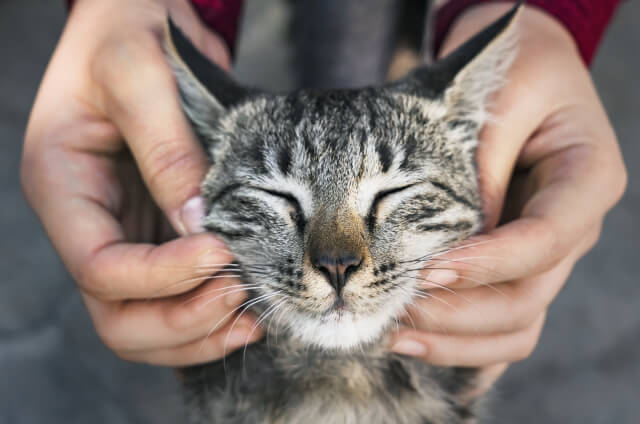
When your cat is bored and under-stimulated, they will go off on their own and find something to entertain them whether you like it or not. Providing consistent training for your cat gives them a healthy medium to express themselves that works for both you and them.
Strengthens the bond between pet and owner
Training time also helps strengthen the bond between you and your pet. By training your pet using positive reinforcement methods, you’ll establish higher levels of trust in your cat toward you.

Additionally, training requires your pet to look to you for guidance and use teamwork to come to a positive result, which will help establish a deeper connection between you both.
Increases the safety and well-being of your cat
The obedience of your cat is a large factor in securing its safety. While cats are smart animals, they may occasionally make mistakes just like us. Training your cat will allow better recall which can help them avoid outside threats such as cars, dangerous animals, or even eating things it isn’t supposed to.

Throughout training sessions with your cat, you will begin to understand both their needs and wants, which may help you prevent accidents in the future.
Think about your training goals
With so many benefits to training, it’s important to think about why you wish to train your cat before starting the process. Do you want to fix unwanted behaviors and encourage good ones? Do you simply want your cat to learn fun tricks?

It’s important to start out small when it comes to training cats. Choosing one initial goal isn’t meant to prevent you from eventually branching out into other areas, but it helps maintain focus and set a solid foundation for you and your cat.
General tips and tricks for training
Start small
Typically, when starting anything new you want to start small, this is the same for cats. Starting out with simple training commands is important as it will ease your cat into the training process. Starting out small will also help prevent your cat from becoming discouraged.
If you start out with extremely complicated tasks, your cat will not receive as many rewards as it would with a simple task. Since this is the beginning of their training, they may begin to resent the process and not get involved which could mess up future training efforts.
Starting out with basic commands such as sit and stay can help your cat build the foundations for a better training experience.
Get rid of distractions
Cats have short attention spans when it comes to humans, so eliminating any distractions that may take their attention away from you is crucial. Pick a quiet area of your home away from others or simply train at a time when others aren’t home if possible.
Other animals in the house or noises from the TV can be distracting and make your cat unable to focus. If you have other pets, consider putting them in a separate room of the house. Additionally, it is generally not recommended to train multiple cats at once.
Don’t punish “bad” behavior
While you shouldn’t use punishment as training for any animal, cats respond especially poorly to using this method. Punishing your cat may not only lead them to resent you and stop listening to you, it will also cause them severe stress and anxiety.
Training is all about building teamwork and a sense of trust between you and your furry friend and punishment could ruin all that progress. Using positive reinforcement is the number one most productive method of training for your cat. Instead of punishing when your cat displays unwanted behavior, redirect their attention or distract them.
While we may view their behavior as undesirable, it could be completely natural and necessary for them. For example, if your cat is scratching your good furniture, it may be because you don’t have a scratching post necessary for them to scratch their claws on.
Get everyone involved
When living in a house with multiple people interacting with your cat, it’s important for everyone to be in on the training. If one person allows the cat to do something that another person is attempting to train them out of, the training will either not work or take a substantially longer amount of time.
All members in the household should at the very least know of the training so that they can correct and consistently address behavior that they’re trying to dissuade.
Consistency is key
In order to avoid confusing your cat it’s important to be consistent with how you go about your training methods. Always use the same voice commands or clickers when using positive reinforcement.
Anyone else interacting with the cat should also familiarize themselves with these cues as well in order to make training go by even smoother and quicker.
Short and sweet
To start out, the length of training sessions should be kept to a minimum. With time you can begin to extend training sessions as you see fit, making sure to consider your cat’s feelings and attention span in mind.
You may find when beginning training that it’s hard to keep the cat’s attention so starting out with two 3-5 minute sessions per day is typically recommended. Later in your training efforts, you may expand two three 5 minute sessions per day or more depending on your cat.
Additionally, it’s essential to always begin and end your cat’s training session on a positive note so that you both feel accomplished over the session.
Figuring out the perfect time
In order to increase the potential for your cat to focus on the training session, finding the right time to start is integral. Choose a time when your cat is typically very active already, either after a quick cat nap or first thing in the morning.
However, it’s important to note that if you pick a time when they have too much energy they will be even more distracted as they simply wish to play. During times like these, you can try to tire them out by playing with them 10 or so minutes before training in order to tire them out a little.
A huge pro tip that works most of the time is to try fitting in training sessions before your cat’s meal time so that they are more willing to work to receive the treat.
Different methods to training your cat
Teaching your cat to obey commands can be accomplished by consistency, dedication, and using the right tools. There are a few different methods of training your cat but here are the most common and popular options.
Clicker training
Clickers are a simple and easy training method that aids in positive reinforcement training. Clickers are small, hand-held tools that make click noises when pressed. The training works by helping your cat identify which behavior you desire from them by “marking” it with the clicker and then rewarding them.
This so-called “click and reward” sequence ultimately helps the cat associate the clicking noise with desirable consequences such as getting treats with certain actions. Using a clicker for cat training is more beneficial than simply using voice commands as you would do with dogs.
Cats can sense changes in voice pitch and intonation easily and with inconsistent voice, comes inconsistent behavior. As we noted before, cats also have relatively short attention spans. By using the clicker, you can provide them with a quick nose that they’ll instantly remember.
High-value treats
Incorporating high-value treats into your cat’s training is another great addition, but what exactly defines a treat as being “high value?” A high-value treat means your cat loves them and doesn’t receive them often, only for training.
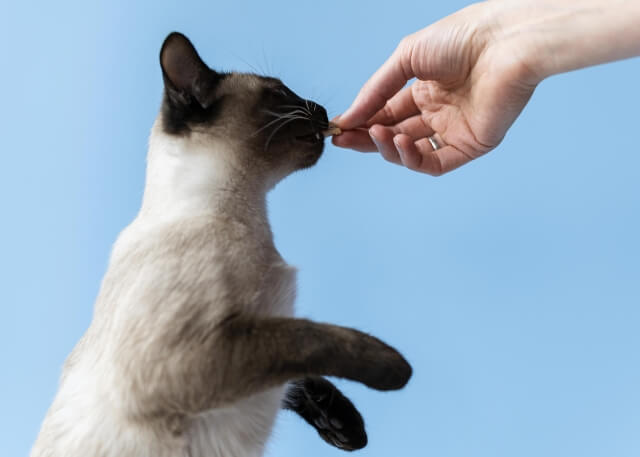
If your cat is used to getting the ‘treat’ for other reasons or doesn’t really care for them, they may decide that the reward isn’t worth what you are asking of them. There are a few other considerations to keep in mind when choosing which treats to use, such as their size and amount of calories. The size of these high-value treats should be small, equivalent to the size of a pea for easy eating. Additionally, the treat should be low in calories.
While training, you’ll be feeding your cat a lot of these treats, and if they are high in calories your cat may become overweight and generally unhealthy. According to Stephanie, an exotic animal trainer and enrichment specialist for over 12 years, these high-value treats should account for “no more than 10% of your cat’s daily calories.”
Target sticks
Target sticks are a training method started by zookeepers that were working with large and/or potentially dangerous animals. A target stick is essentially a long stick with a ball on the end. They help by allowing your pet to physically move through a space without needing to physically force them.
These target sticks can be used individually or in tandem with clicker training and the main objective is to teach your cat to touch an object with a specific part of its body in order to get a reward. Most commonly, people will train their cat to touch the object with either their paws or their nose.
To start out, hold the target near your cat’s face and move it slightly until your cat shows interest in the target stick. After they show interest, reward them with a high-value treat or play behavior. Each time your cat touches the target stick with their nose or paw, move closer to the desired area (such as a crate) until they are there.
Many cats are terrified of their crates, as typically the only time spent in them is for an undesired trip to the vet. Target stick training will teach them that they will be rewarded for getting in the crate themselves, without you having to cause them to stress by physically putting them in yourself.
Beginning commands for your cat
Training your cat doesn’t necessarily have to be complicated or time-consuming, a big mistake people make when it comes to training their cats is trying to do too much too soon. Doing this can overwhelm your cat and make them not want to take part in training sessions.
Starting out with a few simple commands will teach your cat that training with you is a fun and rewarding part of their day.
Sit!
Perhaps one of the most simple and quickest to teach commands for your cat is “sit.” This command will most likely come in handy on a daily basis and is useful in a variety of different situations. First, when you notice your cat sitting, reward them and hit the clicker to mark the positive behavior.
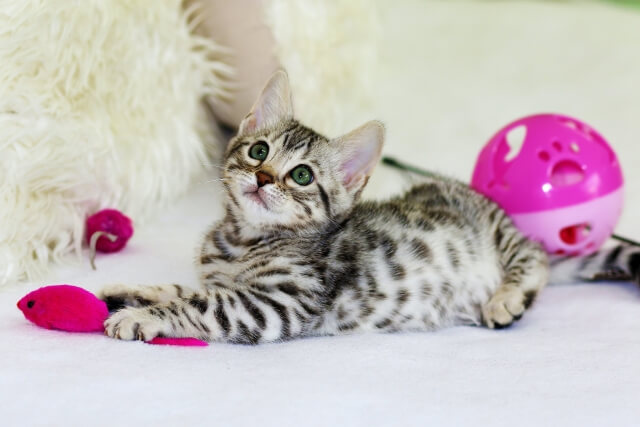
Continue this action until you notice the cat sitting immediately after hearing the clicker. It’s important to note that you should avoid rewarding the cat without hitting the clicker, as this might confuse the cat over why it’s getting rewarded.
Stay!
The stay command is really important when it comes to the overall safety of your furry friend. For example, if your cat is prone to bolting out of the door when it’s opened, teaching them to stay will help keep them inside and away from predators outside. In order to teach your cat to stay, have them start by sitting down and slowly back away from them.
If your cat moves toward you, say no and have them sit again, using the clicker training. Once they sit and stay properly, say “stay” and reward them or mark the positive behavior with the clicker if you’re using that method.
Lay down!
Lay down is another phrase that might come in handy on a day-to-day basis. While training this command is slightly more difficult than the others we’ve covered, it’s attainable with consistency. You can use this command to teach your cat to go to bed or to simply lay down wherever when they might be a little too excited.
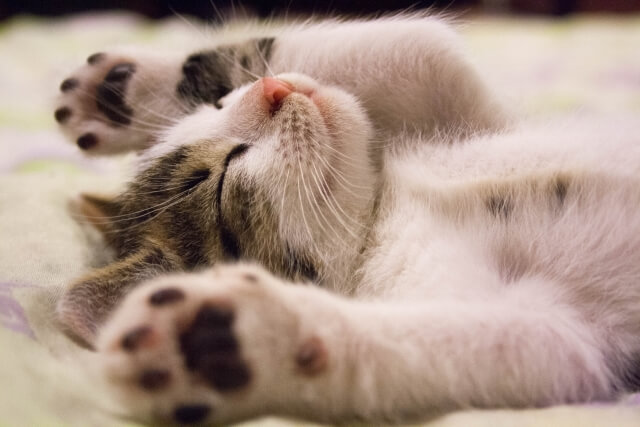
In order to teach the command, first while the cat is sitting, hold a high-value treat in front of their nose. When they begin to smell the treat, lower it down all the way to the floor until your cat follows. Once they are laying down or almost to the floor, say “lay down” and give them the treat. For those who are clicker training, click it after saying lay down and before giving them the treat.
Come!
An additional command that is important for the safety of your cat is ‘come’. Teaching your cat to come to you will help it avoid dangerous animals and potentially help save its life. In order to start teaching your cat this command, make an association between your calling or clicking, and a reward.
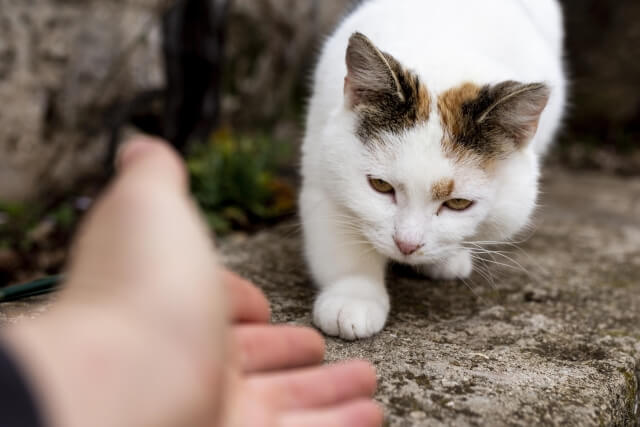
Start out with short distances, firstly standing right next to your cat and calling. Once your cat recognizes your call and listens, keep expanding the distance until your furry friend is out of sight. If your cat still comes to you even when you’re out of its line of sight, you’ve successfully completed teaching this command.
High five!
While teaching your cat to high-five you isn’t really a necessity, it’s definitely a fun and mentally enriching activity for both owner and pet! Possibly the easiest way to teach this command is by using treats your cat deems as high value.
First, sit down in front of your kitty and slightly raise the treat above its head. Continue raising the treat until their head begins to follow the movement of your hand. Once your cat begins to paw at your hand, reward them with the treat and continue repeating the process.
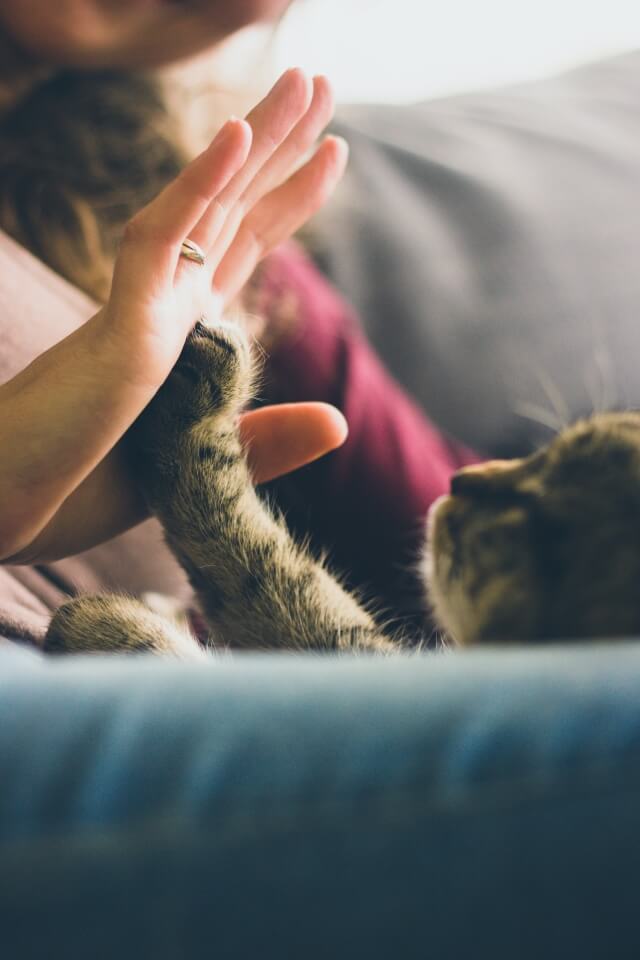
If your cat attempts to get the treat with its mouth before pawing at your hand, start over the process so that they don’t confuse that action with a reward. Eventually, you will be able to do the command without holding a treat for a fun party trick in front of friends and family.
Finishing thoughts
When it comes to training your cats, the effort you put in will determine the effectiveness of the training. There are so many positive results and benefits from training that will make going through the process feel well worth the effort.
It’s important to not feel the urge to rush training, as patience and consistency will yield better results and lessen stress for your furry friend. Whether your goal is teaching crate training, establishing the rules of the house, stopping unwanted behavior, or you simply want to teach your cat a new trick, Our Guide To Cat Training: Tips And Tricks For A Well Behaved Cat is critical to understanding the ins and outs of a well-behaved feline.
You may also like
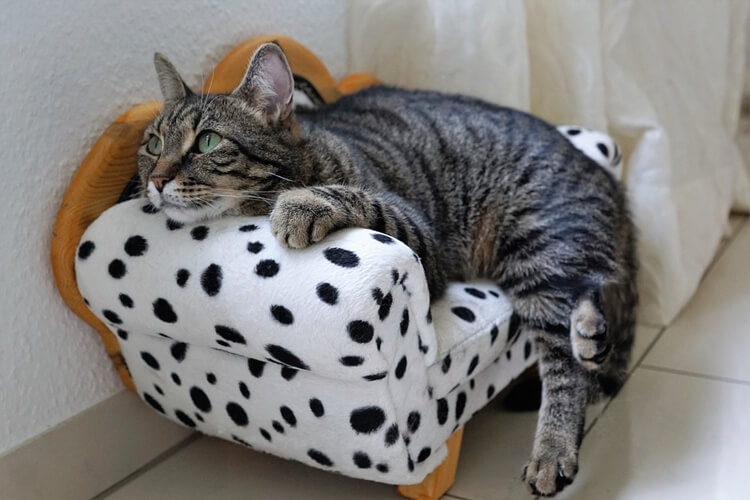
How to Create the Perfect Indoor Environment for Your Cat
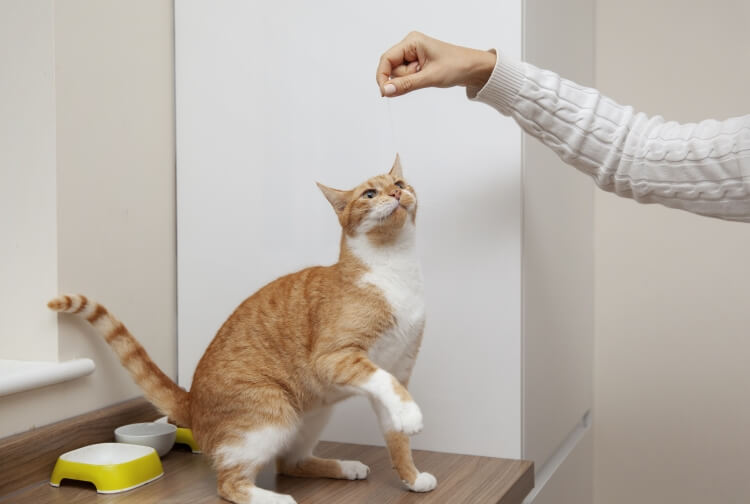
Guide to Cat Training: Tips and Tricks for a Well-Behaved Feline

A Complete Guide to Cat Breeds: Find Your Perfect Furry Friend
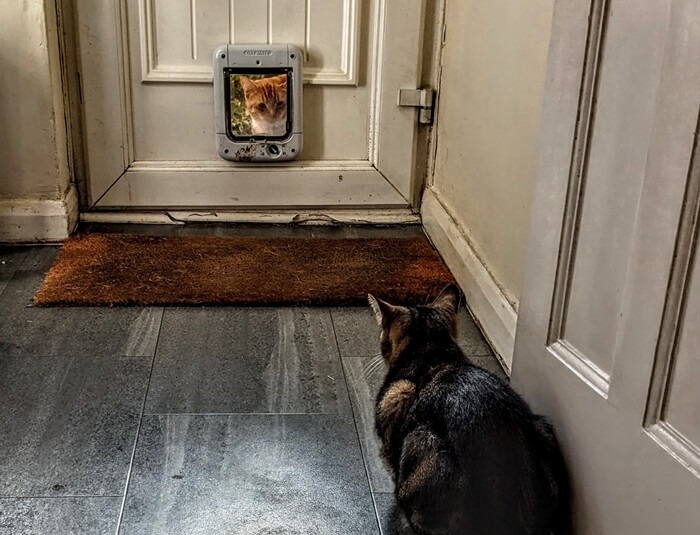
Training Your Cat to Use a Pet Door
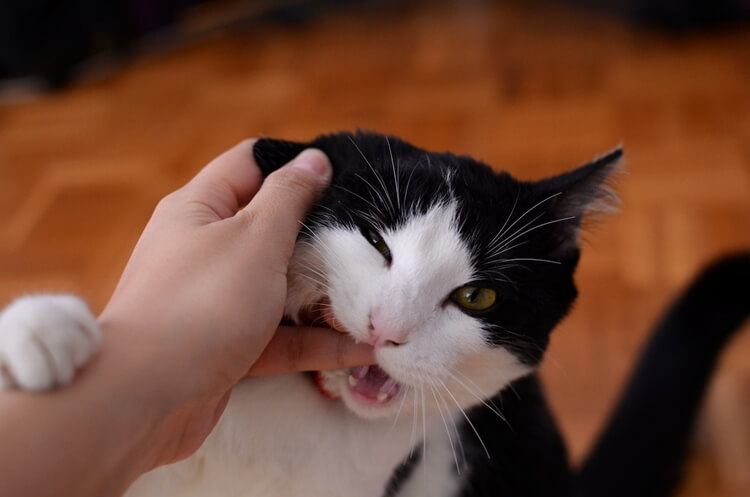
My Cat Keeps Biting Me: Causes and Solutions




